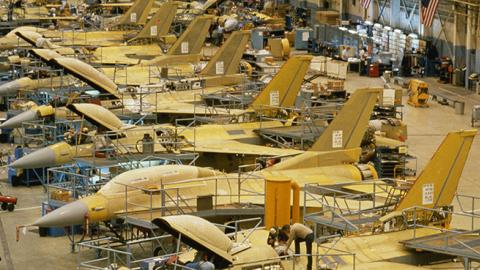Throughout the 20th century, the U.S. manufacturing sector was the defining pillar of the “Arsenal of Democracy.” The size, technological superiority and continuous innovation in this sector allowed not only the preservation of democracy in the great conflagrations of the past century, but also the creation of the global Pax Americana that underlies one of the longest periods of peace and unprecedented prosperity in world history. The slow decline of that industrial superiority, however, is beginning to undermine U.S. economic vitality, as President Trump keeps reminding us, and our ability to support the national security dominance which has been the backbone of global stability for over a century.
A long-awaited report from the Administration released earlier this month is the most comprehensive overview of this growing problem and begins to outline a systematic response to the challenge it represents. The much-anticipated reckoning is among the more significant government reports in generations. It also provides important guidance for the emerging trade and industrial renewal policies of the Trump Administration.
The document states at the outset that “…the erosion of American manufacturing over the last two decades has had a negative impact on these [defense] capabilities…and threatens to undermine the ability of U.S. manufacturing firms to meet security requirements.” The report goes into considerable detail about the loss of U.S. technological leadership and production infrastructure in such critical sectors as robotics, electronics, semiconductors, advanced communications, quantum computing, shipbuilding, some elements of aerospace technology, advanced metal forming, nuclear power, and access to critical raw materials. Another growing concern across many industries is the shortage of skilled production workers and STEM (science, technology, engineering and mathematics) experts.
While many of these issues have been chronicled before, the study marks the first systematic effort to link the growing global competitive environment to the national security needs of the world’s leading superpower. The report minces no words that the rise of China, with its mercantilist and often illegal actions (in terms of agreed international trade rules), is one of the most important factors behind the looming loss of technical leadership so vital to national security. The text states quite unambiguously:
China’s capture of foreign technologies and intellectual property, particularly the systematic theft of U.S. weapons systems and the illicit and forced transfer of dual-use technology, has eroded the military balance between the U.S. and China…. China’s aggressive industrial policies have already eliminated some capabilities with critical defense functions…. China’s actions seriously threaten other capabilities…."
The Administration’s report helps gives substance and specificity to its trade policy. It identifies key sectors and key technologies important to defense capabilities, and the actions by the Chinese which threaten them. The catalogue of industries and technologies also provides guidance to the recently strengthened CFIUS(Committee on Foreign Investment in the United States) law which allows U.S. authorities to review and block, if necessary, foreign acquisitions of key parts of the defense industrial base. The report’s emphasis on skills training in both the scientific and production jobs in industries like nuclear power, shipbuilding and large metal forging also is helpful to the work of the President’s new National Council for the American Worker. The group is charged with leading an interdepartmental, government-wide effort to find ways to overcome gaps in essential skills. Finally, the report outlines a series of additional Federal actions to address the problems outlined in the report. These include improving procurement strategies, strengthening and broadening the domestic supply chain for domestic production, and using Department of Defense programs to support specific defense-critical industrial production and technology development.
In an opinion piece accompanying the release of the report, Assistant to the President for Trade and Manufacturing Policy Peter Navarro rightly argued that the President’s tax reform and deregulatory agenda is also important in helping renew American manufacturing. There is always some danger that the clarion call to rebuild specific industries, especially in a time of heightened global competition from a rising superpower, will be carried too far and the hand of government will weigh too heavily on the traditional dynamism of the American private sector. Finding the right balance among all the government tools—including trade, education, regulation and industrial support programs—is never easy, but the new report gives urgency to addressing the problems and clarity about the industries that are essential to national security. The complacency of recent decades needs to be replaced by a new determination to find the right balance of more activist policies in support of a 21st-century Arsenal of Democracy.













